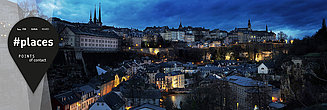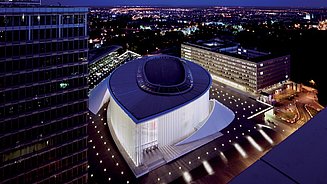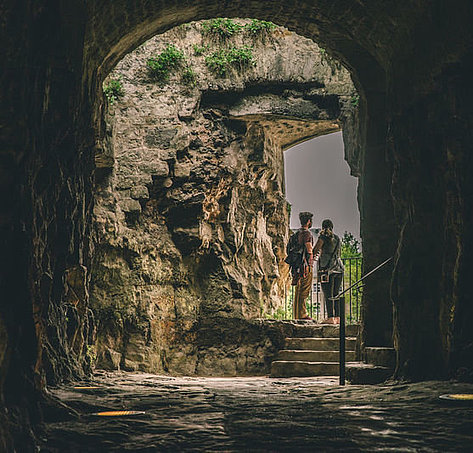A city of contrasts: Luxembourg #places
4 min read#places: Luxembourg
Country: Luxembourg
Inhabitants: ca. 613,894
Area: 2,586.4 km2
Nowhere else in Europe do so many cultures, mentalities and languages harmoniously meet in such a small space. Almost 70% of the city's inhabitants are foreigners, making Luxembourg the most multicultural city in Europe. For many years, the city of Luxembourg has been a UNESCO World Heritage Site. Ultramodern buildings fit seamlessly into the original cityscape, which is witness to a colorful past. Luxembourg is a modern city with old roots. Mostly known as a financial center, it is often forgotten that the city of Luxembourg is also home to various European institutions.
Architecture
The Musée d'Art Moderne Grand-Duc Jean (MUDAM) is one example for a contrast between modern and historical architecture. The famous architect Chinese-American Ieoh Ming Pei chose the historic location of Fort Thüngen for the construction of the museum which opened its doors in July 2006. Only with the construction of the MUDAM the walls of the fort were re-exposed and reconstructed, because the architect has decided to build the new museum on the outer walls of the original fortress. The museum, located on the Kirchberg Plateau, between the Place de l'Europe and the old town of Luxembourg, invites you to discover contemporary art. The Luxembourg Government decided to call the cultural institution "Musée d'Art Moderne Grand-Duc Jean" to commemorate the 25 year rule of Grand Duke Jean, who was Grand Duke of Luxembourg from 1964 to 2000, before he abdicated in favor of his eldest Son Grand Duke Henri. With its collection, exhibitions, program and partnerships, Mudam aims to collect and present the most significant art of our time, and to make it accessible to the widest possible audience.
Address: 3, Park Dräi Eechelen, 1499 Luxembourg
The Philharmonie Luxembourg, also known officially as the Grande-Duchesse Joséphine-Charlotte Concert Hall, is located in the European district, houses the Luxembourg Philharmonic Orchestra since 2015 and shines in a spectacular white. The elegant façade of the Philharmonie, built according to the plans of the French architect Christian de Portzamparc, defines the Place de l'Europe. The slender columns form the framework for three concert halls, which accommodate 120 to 1,500 guests.Christian de Portzamparc wanted to install a ring of trees that visitors would have to cross to enter the field of music forgetting the environment. He quickly converted this idea, for lack of space, into a huge peristyle composed of 827 vertical lines constituting a foyer all around the Grand Auditorium. It is a filter of light through which one can choose to see or forget the outside. This filter-facade surrounds the lobby, which is a long peristyle surrounding the concert hall and the boxes.
Address: 1 Place de l'Europe, 1499 Luxembourg
Interesting Places
The Bock casemates - the name comes from the rock where they are located - can be found in the Montée de Clausen. They are a UNESCO World Heritage Site and are definitely worth exploring! Also known as Gibraltar of the North, the former tunnel defense system of the old fortress stretches over 23 kilometers inside the rocks. Unfortunately, only a part of these tunnels is accessible and open to the public. On warm summer days, the cool walls of the casemates are a nice refreshment, as you can go down up to 40 meters in the rock on different levels. Take the time and enjoy the beautiful view from Bockfelsen over the whole city!
Address: 10 Montée de Clausen, 1343 Luxembourg
Restaurants and Cafés
Luxembourg is best known for its countless pâtisseries and chocolateries, representing its francophile influence. But the Luxembourg cuisine reflects in every way the cultural diversity of the country.
The Chocolate House is located opposite the Grand Ducal Palace. As the name implies, there is chocolate here in all varieties. On the spot for drinking, as a cake and tartlet, but also as a souvenir in many variations. One of the most famous Chocolate House products is the chocolate spoon which customers can dip into hot milk.
Address: 20 Rue du Marché-aux-Herbes, 1728 Luxembourg
The Kaempff-Kohler restaurant opposite the Hôtel de Ville impresses with fine regional dishes and pretty, but also delicious tartlets and the famous Macaroons Made in Luxembourg. Only selected, fresh, local, high-quality products are processed according to strict criteria among the best products of the market. The traditional Riesling pie - "Rieslingpaschtéit" - created in 1928 by the founder of the house Pierre Kaempff traditional Rieslingpastete will delight your taste. Furthermore the restaurant has a cheese shop with over 180 different cheeses - from the freshest to the slow-ripened - a great wine selection and a cheese tasting with home-baked bread.
Address: Fromagerie: 18 Rue du Cure, Luxembourg
Restaurant: 18 Place Guillaume, 1648 Luxembourg
Restaurant: 40 Rue Gabriel Lippmann, 6947 Niederanven









